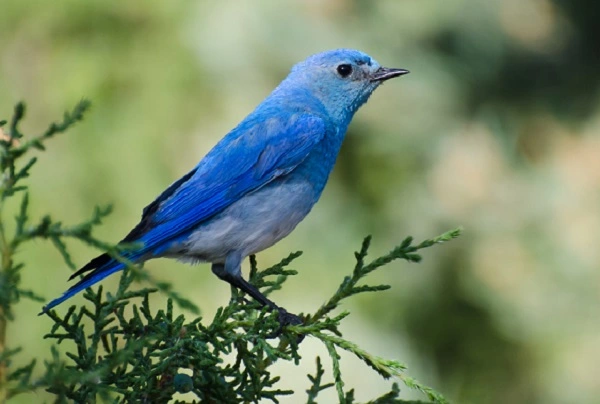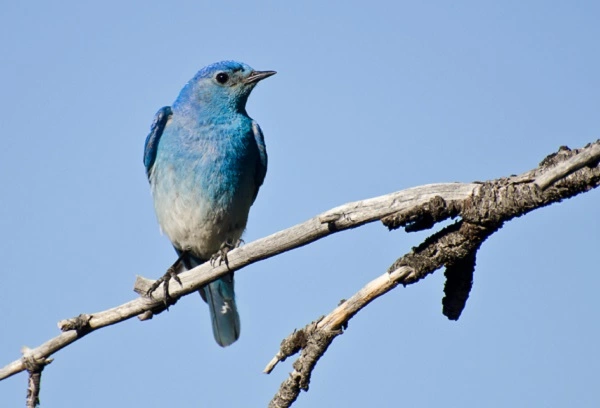The mountain bluebird is one of the most beautiful and easily identifiable birds in North America. These striking birds can be found in the Rocky Mountains and other mountainous areas across the continent. In this post, we will take a closer look at the mountain bluebird, its habitat, diet, and behavior. We will also discuss ways to help protect these amazing creatures. So read on to learn more about these fascinating birds!

Mountain Bluebird Description
The Mountain Bluebird is a small thrush with blue upperparts and a white belly. It has a white throat and dark eyes. The Mountain Bluebird is found in open country in the western US and Canada. It nests in cavities in cliffs or trees. The Mountain Bluebird is about 6-7 inches long with a wingspan of 10-12 inches. The Mountain Bluebird eats insects, spiders, and berries.
Mountain Bluebird Habitat
The Mountain Bluebird (Sialia currucoides) is a small thrush found in western North America. Mountain bluebirds are some of the easiest birds to identify, thanks to their striking blue plumage. These beautiful birds are also interesting for their habitat preferences. Mountain bluebirds typically nest in cavities in cliffs or trees, but they will also use man-made structures such as nesting boxes. Mountain bluebirds often form small colonies, and will sometimes compete with other cavity-nesting birds such as the house wren or mountain chickadee for nesting sites. In addition to their bright plumage, Mountain bluebirds are also known for their cheerful song, which can be heard throughout the spring and summer months.
Mountain Bluebird Diet
Mountain bluebirds are small thrushes that breed in open areas in western North America. They are distinctive for their bright blue plumage and their diet consists primarily of insects and spiders, which they capture in mid-air or pick from the ground. Mountain bluebirds will also eat berries and seeds, particularly in winter when insects are scarce. Mountain bluebirds generally forage alone or in pairs, but they will sometimes join mixed flocks of other insectivorous birds. Mountain bluebirds typically nest in cavities, either in natural tree hollows or in man-made birdhouses. Mountain bluebirds typically lay between three and seven eggs per clutch. The female incubates the eggs for about two weeks, and the young birds fledge (leave the nest) after another two weeks. Mountain bluebirds typically live for about four years in the wild, although some individuals have been known to live much longer.

Mountain Bluebird Size
The Mountain Bluebird is a stunning bird with a vibrant blue plumage. Both male and female birds have blue feathers, but the males tend to be more brightly coloured. Mountain Bluebirds are small birds, with an average length of around 20 cm. They have long, slender beaks that are well adapted for eating insects. Mountain Bluebirds are found in mountainous regions of North America. They typically nest in cavities in trees, rocks or cliffs. Mountain Bluebirds usually lay between three and seven eggs per clutch. These beautiful birds are a favourite among birdwatchers and nature enthusiasts.
Mountain Bluebird Lifespan
Mountain bluebirds are small thrushes that are found in the mountain ranges of western North America. They are a beautiful bird, with blue feathers and a white belly. Mountain bluebirds typically live for around 10 years in the wild, although some have been known to live for up to 15 years. Mountain bluebirds generally have a good life expectancy, as they are not subject to many predators and do not face many dangers in their natural habitats. However, there are some threats to their survival, such as climate change and habitat loss. Mountain bluebirds are also sometimes killed by cars or power lines. Despite these threats, mountain bluebirds are still relatively common, and their population is considered to be stable.
Mountain Bluebird Behavior
Mountain bluebirds are a striking blue color with white bellies. They are the only species of bluebird found in the Mountain West. They are slightly smaller than other bluebird species and have a longer tail. Mountain bluebirds are found in open habitats such as meadows, pastures, and sagebrush steppe. In the summer, they eat insects and spiders. In the winter, they eat berries and fruits. Mountain bluebirds are monogamous and mate for life. The female Mountain bluebird builds the nest out of grass, bark, and leaves lined with hair or feathers. She lays 3-7 eggs which hatch after two weeks. The male Mountain bluebird brings food to the female while she is incubating the eggs and caring for the nestlings. Nestlings leave the nest after three weeks. Mountain Bluebirds often have 2-3 broods per year. Mountain Bluebirds are agile flyers and can hover in mid-air to catch insects. They sometimes form flocks in the winter. Mountain Bluebirds are generally not aggressive towards other birds but will defend their nesting sites from other Mountain Bluebirds.
Mountain Bluebird Speed
The Mountain Bluebird is a stunning bird with a sleek blue body and wings. It is also one of the fastest birds in North America, reaching speeds of up to 80 miles per hour. The Mountain Bluebird is most often seen in open areas such as fields and meadows. It feeds primarily on insects, although it will also eat berries and other fruits. Mountain Bluebirds typically mate for life and build their nests in tree cavities. In recent years, the Mountain Bluebird population has declined due to habitat loss and nest predation. However, measures are being taken to protect this beautiful bird and its habitat.
Mountain Bluebird Hunting
Mountain bluebirds are one of the most popular game birds in North America. They are highly prized for their beautiful plumage, and their meat is considered to be some of the best-tasting game bird meat available. Mountain bluebirds can be found in open mountain meadows and forests, and they are known for their energetic flying style. When hunting mountain bluebirds, it is important to be aware of their habits and patterns. Mountain bluebirds typically fly in large flocks, so it is important to find a likely feeding or roosting area and set up an ambush. Once the birds are located, hunters should be prepared for a fast and unpredictable shoot. Mountain bluebirds are notoriously difficult to hit, but with practice and patience, they can provide a challenging and rewarding hunting experience.
Conclusion
The mountain bluebird is an interesting bird that can be found in the western United States. They are known for their beautiful coloring and their songs. If you’re lucky enough to spot a mountain bluebird, make sure to take some pictures or videos to share with your friends!
Frequently Asked Question

